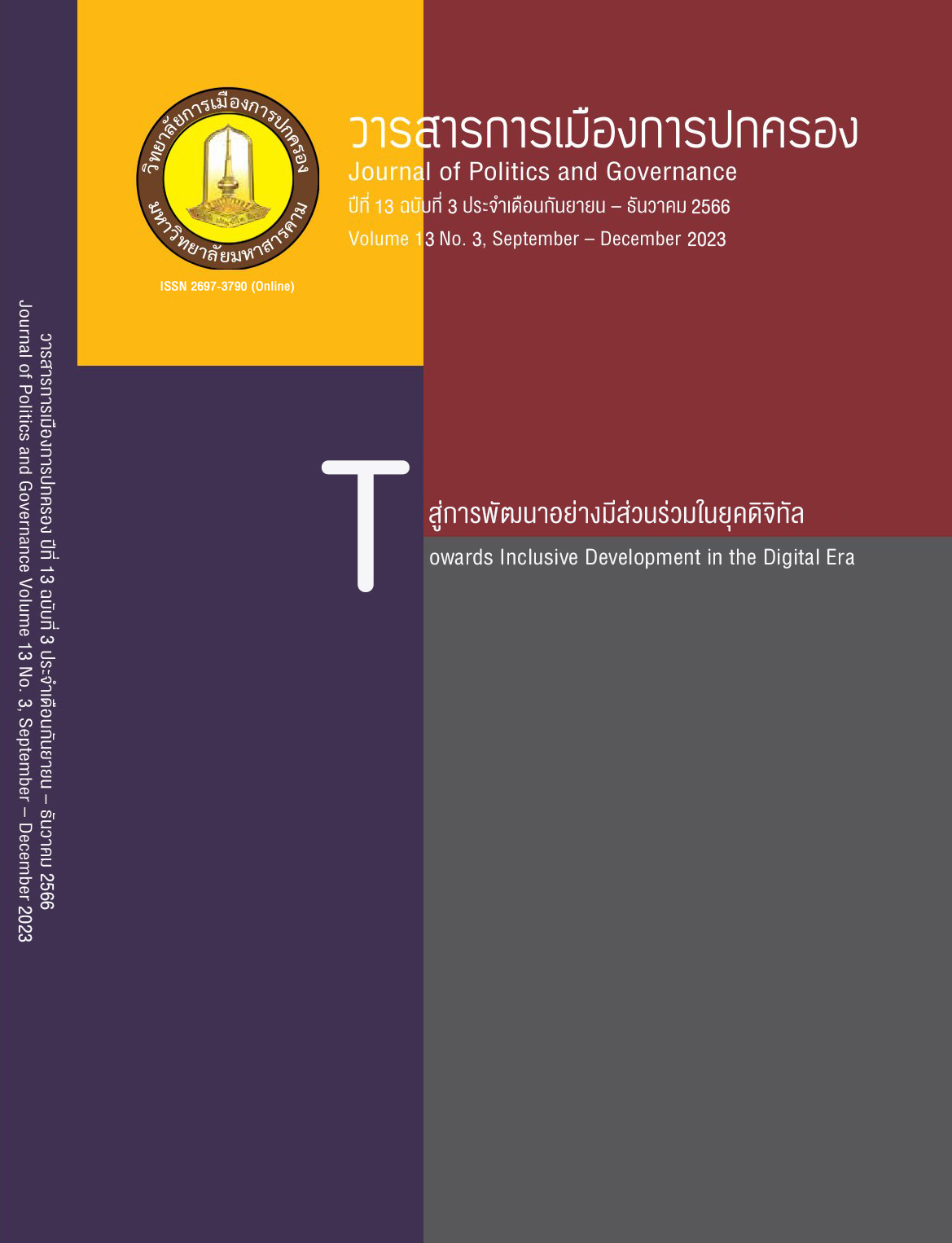การพัฒนาเส้นทางจักรยานและการผลักดันการใช้จักรยานเป็นรูปแบบคมนาคมหลัก: กรณีศึกษากรุงอัมสเตอร์ดัม ประเทศเนเธอร์แลนด์
Main Article Content
บทคัดย่อ
บทความนี้มุ่งศึกษาการพัฒนาเส้นทางจักรยานและการผลักดันการใช้จักรยานในพื้นที่ กรุงอัมสเตอร์ดัมให้เป็นเมืองที่ใช้จักรยานเป็นรูปแบบการคมนาคมหลักของเมือง ซึ่งเป็นส่วนหนึ่งในการพัฒนาเมืองอัมสเตอร์ดัม ให้เป็นเมืองที่เป็นมิตรกับการใช้จักรยาน และมีชื่อเสียงเป็นที่รู้จักระดับโลกอย่างต่อเนื่องในการขนานนามว่าเป็นเมืองหลวงแห่งจักรยาน ซึ่งเป็นส่วนหนึ่งในการพัฒนาประเทศเนเธอร์แลนด์ไปสู่การพัฒนาที่ยั่งยืนด้านการคมนาคม โดยบทความนี้มีวัตถุประสงค์ คือ 1) เพื่อศึกษาการพัฒนาเส้นทางจักรยานและการผลักดันการใช้จักรยานในพื้นที่กรุงอัมสเตอร์ดัม 2) เพื่อวิเคราะห์การพัฒนาเส้นทางจักรยาน และการผลักดันการใช้จักรยานในพื้นที่กรุงอัมสเตอร์ดัมเป็นการคมนาคมหลักผ่านแนวคิดทฤษฎีที่นำมาใช้ในการพัฒนา และ 3) เพื่อเปรียบเทียบการพัฒนาเส้นทางจักรยานและการผลักดันการใช้จักรยานในกรุงอัมสเตอร์ดัมกับพื้นที่กรุงเทพมหานคร ผลการศึกษาพบว่า 1) การพัฒนาเกี่ยวกับการใช้จักรยานในอัมสเตอร์ดัมเกิดขึ้นอย่างต่อเนื่อง แบบค่อยเป็นค่อยไป โดยรัฐมีแนวทางการพัฒนาอย่างจริงจัง 2) สามารถอธิบายได้ผ่านแนวคิด ที่อัมสเตอร์ดัมนำมาพัฒนาและผลักดันการใช้จักรยานได้ 3 แนวคิดหลัก ได้แก่ แนวคิดเมืองอัจฉริยะ (Smart City) ทฤษฎีเศรษฐศาสตร์แบบโดนัท (Doughnut Economics Theory) และแนวคิด การมีส่วนร่วมของประชาชน (Public Participation Approach) และ 3) เมื่อวิเคราะห์เปรียบเทียบกับพื้นที่กรุงเทพมหานครพบว่า ทั้งสองพื้นที่มีลักษณะใกล้เคียงกันหลายประการที่เกี่ยวข้องกับ การใช้จักรยาน ซึ่งพื้นที่กรุงเทพมหานครสามารถนำแนวทางและแนวคิดในการพัฒนาของอัมสเตอร์ดัมมาเป็นแบบอย่างในการพัฒนาตามบริบทพื้นที่ของกรุงเทพมหานครได้
Article Details

อนุญาตภายใต้เงื่อนไข Creative Commons Attribution-NonCommercial-NoDerivatives 4.0 International License.
เอกสารอ้างอิง
กนกวรรณ มะสุวรรณ. (2566, 20 กุมภาพันธ์). “Amsterdam” “มุ่งสร้างเศรษฐกิจที่ยั่งยืนและ การมีคุณภาพชีวิตที่ดี”. https://www.utel.co.th/th/news-detail/21
กวิน ชุติมา. (2558, 10 พฤษภาคม). บทเรียนเกี่ยวกับจักรยานจากอัมสเตอร์ดัมที่ไม่มีใครพูดถึง. https://www.posttoday.com/lifestyle/364049
กรกฎ พัลลภรักษา. (2563, 21 กรกฎาคม). เมื่อรถยนต์คือแขกรับเชิญ ในเมืองจักรยาน อัมสเตอร์ดัม. https://theurbanis.com/mobility/21/07/2020/1967
เกียรติขจร วัจนะสวัสดิ์. (2550). การมีส่วนร่วมของประชาชนต่อการดำเนินนโยบายของรัฐบาล ด้านการบริการจัดหางาน. กรุงเทพฯ: กองแผนงานและสารสนเทศ กรมการจัดหางาน กระทรวงแรงงาน.
ชัชชาติ สิทธิพันธุ์. (2565, 26 เมษายน). สร้างย่านจักรยาน เดินทางได้ทั่วด้วยการปั่น (Bicycle Corridor). https://www.chadchart.com/policy/624ad29297c037fe0be0b6eb/
ไทยรัฐออนไลน์. (2558, 13 มีนาคม). ยังปั่นกันสนุ้ก…สนุก! ‘อัมสเตอร์ดัม’ กับแชมป์ ‘เมืองหลวงจักรยานโลก’. https://www.thairath.co.th/news/foreign/486570#:~:text=กรุงอัมสเตอร์ดัม%20เมืองหลวงของประเทศ,บนถนนบนสะพาน,%20หน้า
ธงชัย พรรณสวัสดิ์. (2565, 11 พฤษภาคม). ผู้ว่ากรุงเทพมหานครกับจักรยาน. https://www.thaipost.net/articles-news/139715/
ธนัชชา นารัตน์โท. (2563). ปัจจัยที่เป็นอุปสรรคต่อความสำเร็จของเส้นทางจักรยานกรณีเปรียบเทียบเส้นทางจักรยาน 3 เส้นทางในกรุงเทพมานคร. (การค้นคว้าอิสระ ปริญญามหาบัณฑิต,มหาวิทยาลัยศิลปากร). Silpakorn University Repository (SURE). https://sure.su.ac.th/xmlui/handle/123456789/25371
พิชญาพร โพธิ์สง่า. (2565, 18 กันยายน). “จักรยานคันแรก” เปลี่ยนกรุงเทพฯ เมืองนักปั่น. https://theactive.net/read/inspired-first-bicycles/
รวีวรรณ วิโรจน์วรรณ. (2561). แนวทางในการพัฒนาเส้นทางการปั่นจักรยานสำหรับนักท่องเที่ยว บริเวณพื้นที่บางกระเจ้า อำเภอพระประแดง จังหวัดสมุทรปราการ. วารสารปัญญาภิวัฒน์, 10(3), 96-109
วณัฐย์ พุฒนาค. (2565, 16 มีนาคม). น้ำมันแพงไม่เป็นไร วิธีที่อัมสเตอร์ดัมกลายเป็นเมืองจักรยาน กับการไม่ยอมยกเมืองให้รถตั้งแต่ยุค 70S. https://citycracker.co/city-design/amsterdam-bike-city/
สมปอง หลวงลือชัย, และองุ่นทิพย์ ศรีสุวรรณ. (2563). ประสบการณ์การออกแบบเครือข่ายทางจักรยานสู่ต้นแบบเส้นทางจักรยานเพื่อการท่องเที่ยวในภูมิภาคเอเชียตะวันออกเฉียงใต้. วารสารวิชาการ ศิลปะสถาปัตยกรรมศาสตร์ มหาวิทยาลัยนเรศวร, 11(1), 214-232
อาศิรา พนาราม. (2564, 19 พฤศจิกายน). “Public Eye” อัมสเตอร์ดัม สมาร์ทซิตี้ที่ความเป็นส่วนตัวคือเรื่องสำคัญ. https://www.bangkokbiznews.com/world/972887
Beyondyaovy. (2566, 6 สิงหาคม). วัฒนธรรมการใช้ “จักรยานของชาวดัตช์” ดินแดนนักปั่นระดับโลก. https://beyondyaovy.com/the-dutch-cycling-culture/
Caayaupan, R. B. (1985). Participation Approach: A Must in Rural Development. Occasional Paper Series on Community Management.
Doughnut Economics Action Lab. (2023). About Doughnut Economics. https://doughnuteconomics.org/about-doughnut-economics
Kate Raworth. (2018, April). A healthy economy should be designed to thrive, not grow. https://www.ted.com/talks/kate_raworth_a_healthy_economy_ should_be_designed_to_thrive_not_grow?language=ro
Municipality of Amsterdam. (2020). Amsterdam Circular 2020-2025 Strategy. Amsterdam: City of Amsterdam.
Municipality of Amsterdam. (2020). THE AMSTERDAM CITY DOUGHNUT A TOOL FOR TRANSFORMATIVE ACTION. Amsterdam: City of Amsterdam.
Renate van der Zee. (2015, May 5). How Amsterdam became the bicycle capital of the world. https://www.theguardian.com/cities/2015/may/05/amsterdam-bicycle-capital-world-transport-cycling-kindermoord
Thomas Ricker. (2023, January 27). Amsterdam’s underwater parking garage fits 7,000 bicycles and zero cars. https://www.theverge.com/23572761/amsterdam-underwater-bike-garage-future-of-transport


